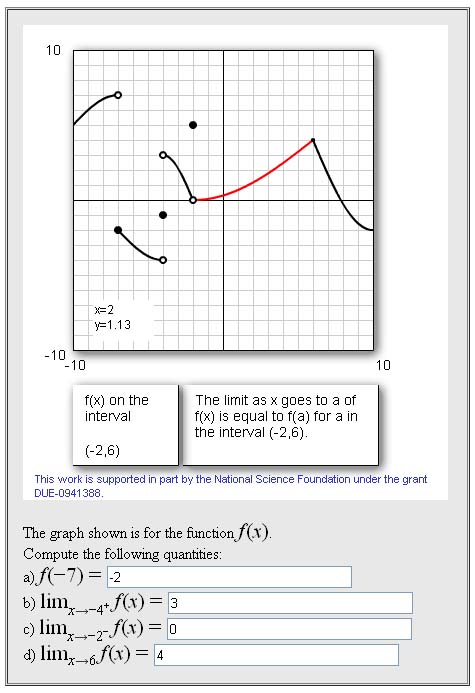GraphLimit Flash Applet Sample Problem
Flash Applets embedded in WeBWorK questions GraphLimit Example
Sample Problem with GraphLimit.swf embedded
This sample problem shows how to use this versatile applet.
A standard WeBWorK PG file with an embedded applet has six sections:
- A tagging and description section, that describes the problem for future users and authors,
- An initialization section, that loads required macros for the problem,
- A problem set-up section that sets variables specific to the problem,
- An Applet link section that inserts the applet and configures it, (this section is not present in WeBWorK problems without an embedded applet)
- A text section, that gives the text that is shown to the student, and
- An answer and solution section, that specifies how the answer(s) to the problem is(are) marked for correctness, and gives a solution that may be shown to the student after the problem set is complete.
The sample file attached to this page shows this; below the file is shown to the left, with a second column on its right that explains the different parts of the problem that are indicated above. A screenshot of the applet embedded in this WeBWorK problem is shown below:

There are other example problems using this applet:
GraphLimit Flash Applet Sample Problem 2
And other problems using applets:
Derivative Graph Matching Flash Applet Sample Problem
USub Applet Sample Problem
trigwidget Applet Sample Problem
solidsWW Flash Applet Sample Problem 1
solidsWW Flash Applet Sample Problem 2
solidsWW Flash Applet Sample Problem 3
Other useful links:
Flash Applets Tutorial
Things to consider in developing WeBWorK problems with embedded Flash applets
| PG problem file | Explanation |
|---|---|
##DESCRIPTION
## Graphical limits
## Sample problem to illustrate
## the use of the GraphLimit.swf
## Flash applet
##ENDDESCRIPTION
## KEYWORDS('limits')
## DBsubject('Calculus')
## DBchapter('Limits')
## DBsection('Graphical limits')
## Date('7/5/2011')
## Author('Barbara Margolius')
## Institution('Cleveland State University')
## TitleText1('')
## EditionText1('2011')
## AuthorText1('')
## Section1('')
## Problem1('')
###########################################
# This work is supported in part by
# the National Science Foundation
# under the grant DUE-0941388.
###########################################
|
This is the tagging and description section of the problem. Note that any line that begins with a "#" character is a comment for other authors who read the problem, and is not interpreted by WeBWorK. The description is provided to give a quick summary of the problem so that someone reading it later knows what it does without having to read through all of the problem code. All of the tagging information exists to allow the problem to be easily indexed. Because this is a sample problem there isn't a textbook per se, and we've used some default tagging values. There is an on-line list of current chapter and section names and a similar list of keywords. The list of keywords should be comma separated and quoted (e.g., KEYWORDS('calculus','derivatives')). |
DOCUMENT(); loadMacros( "PGstandard.pl", "AppletObjects.pl", "MathObjects.pl", ); |
This is the initialization section of the problem. The first executed line of the problem must be the
The |
# Set up problem
$qtype='limits';
$showHint = 0;
if(time>$dueDate){
$showHint=1;
}
$x1=random(-8,-2,1);
$x2=$x1+random(2,4,1);
$x3=$x2+random(2,3,1);
$x4=random($x3+2,7,1);
|
The GraphLimits.swf applet will accept four different question types, specified with the
The applet has solution/hint information embedded in it. When
The four variables |
#######################################
# How to use the Graph_Test applet.
# Purpose: The purpose of this
# applet is to ask graphical
# limit questions
# Use of applet: The applet
# state consists of the
# following fields:
# qType - question type: limits,
# continuity, first_derivative,
# second_derivative
# hintState - context sensitive
# help is either on or off.
# Generally turned on after
# dueDate
# problemSeed - the seed sets
# the random parameters that
# control which graph is
# chosen. If the seed is
# changed, the graph is
# changed.
#######################################
# qType = limits
# right_limits - returns a
# list of points (a,b)
# such that
# lim_{x\to a^-}f(x)=b,
|
|
BEGIN_TEXT
$BR
The graph shown is for the
function \(f(x)\).
$BR Compute the following
quantities:
$BR
a)
\(f($x1)=\)
\{ans_rule(35) \}
$BR
b)
\(\lim_{x\to {$x2}^+}f(x)=\)
\{ans_rule(35) \}
$BR
c)
\(\lim_{x\to {$x3}^-}f(x)=\)
\{ans_rule(35) \}
$BR
d)
\(\lim_{x\to {$x4}}f(x)=\)
\{ans_rule(35) \}
$BR
END_TEXT
Context()->normalStrings;
|
This is the text section
of the problem. The
Mathematical equations are delimited by
There are a number of variables that set
formatting: |
############################# # # Answers # ## answer evaluators ANS( $correctAnswer1->cmp() ); #checks AnSwEr00001 ANS( $correctAnswer2->cmp() ); #checks AnSwEr00002 ANS( $correctAnswer3->cmp() ); #checks AnSwEr00003 ANS(num_cmp($correctAnswer4, strings=>['DNE'])); #checks AnSwEr00004 ENDDOCUMENT(); |
This is the answer
section of the problem. The problem answer
is set by the The solution is embedded in the applet and becomes available when the due date has passed.
The |